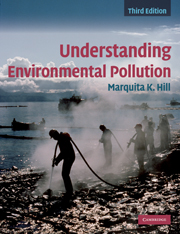Book contents
- Frontmatter
- Contents
- Preface
- Acknowledgements
- List of abbreviations and acronyms
- 1 Understanding pollution
- 2 Reducing risk, reducing pollution
- 3 Chemical toxicity
- 4 Chemical exposures and risk assessment
- 5 Air pollution
- 6 Acid deposition
- 7 Global climate change
- 8 Stratospheric ozone depletion
- 9 Water pollution
- 10 Drinking-water pollution
- 11 Solid waste
- 12 Hazardous waste
- 13 Energy
- 14 Persistent, bioaccumulative, and toxic
- 15 Metals
- 16 Pesticides
- 17 Pollution at home
- 18 Zero waste, zero emissions
- 19 Chemistry: some basic concepts
- Index
- References
7 - Global climate change
Published online by Cambridge University Press: 05 June 2012
- Frontmatter
- Contents
- Preface
- Acknowledgements
- List of abbreviations and acronyms
- 1 Understanding pollution
- 2 Reducing risk, reducing pollution
- 3 Chemical toxicity
- 4 Chemical exposures and risk assessment
- 5 Air pollution
- 6 Acid deposition
- 7 Global climate change
- 8 Stratospheric ozone depletion
- 9 Water pollution
- 10 Drinking-water pollution
- 11 Solid waste
- 12 Hazardous waste
- 13 Energy
- 14 Persistent, bioaccumulative, and toxic
- 15 Metals
- 16 Pesticides
- 17 Pollution at home
- 18 Zero waste, zero emissions
- 19 Chemistry: some basic concepts
- Index
- References
Summary
“Anyone who has kids must be … concerned about the climate future we're leaving behind for them. The choices that we make today on the “what to do” about climate change will have long lifetimes … Our actions are changing the climate on a global scale. It's happening now. We can't pretend it's not there.”
Ben Santer, climate modeler at the US Department of Energy's Lawrence Livermore National LaboratoryClimate change is nothing new. About 18,000 years ago, Earth was experiencing the last of many ice ages, from which it only emerged about 10,000 years ago. More recently, between the years 1430–1850 portions of the Earth passed through a little ice age. The role of greenhouse gases, especially water vapor and carbon dioxide (CO2), in warming the Earth is also ancient, and indeed has long served life on Earth well. Figure 7.1 shows a representation of this phenomenon. Radiation from the sun reaches and warms the Earth's surface. In turn, Earth emits radiant heat (infrared radiation) back toward space, part of which is captured by heat-trapping water vapor and greenhouse gases. Without the “greenhouse effect” to trap this warmth, the Earth could be colder by 95ºF (35ºC), and not support life as we know it. However, the last century has brought greater warming beyond that which can be accounted for by natural causes, and warming is occurring at a faster rate. It is this, which we examine in this chapter.
- Type
- Chapter
- Information
- Understanding Environmental Pollution , pp. 170 - 212Publisher: Cambridge University PressPrint publication year: 2010



